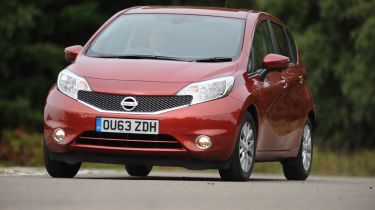Nissan Note (2013-2017) review - MPG, CO2 and Running Costs
Very good fuel economy across the range means low CO2; Nissan reliability helps keep running costs in check

All Nissan Notes are economical, fuel-efficient cars. Even the base 1.2-litre 80 engine averages 60.1mpg – it’s no low-tech alternative, despite its entry-level price. Sub-110g/km CO2 is impressive as well: it’s a good choice if your demands are low.
The better choice is the 1.2 DiG-S 98 engine, though. Not only is this engine faster, torquier and more flexible, it’s also more fuel-efficient – an extremely impressive blend of conflicting attributes. It officially averages 65.7mpg on the combined cycle and also emits just 99g/km CO2, thus pre April 2017 cars dip below the 100g/km road-tax exemption benchmark.
Do note, however, pairing it with the supposedly efficient automatic Xtronic gearbox inflicts a significant fuel economy hit. Combined efficiency drops to just 55.4mpg and CO2 emissions go up four tax bands to 119g/km.
The diesel is naturally the most fuel-efficient choice. It averages an exceptional 80.7mpg and emits just 90g/km CO2 – when you factor in the Note’s space and flexibility, it gives terrific bang for your buck in terms of fuel costs. Do also note, all Nissan Note models come with engine idle stop-start as standard, boosting city centre fuel economy.
While the Note’s Driver Power overall result was a bit disappointing in 2015, it fared much more strongly for running costs, suggesting owners are pleased with its real world performance.
Insurance groups
Insurance groups are generally low for the Note, meaning it should be affordable to insure. All 1.2 80 models apart from the sporty-look n-tec are in group 6; the more stylish n-tec moves up just one group, to 7.
Used - available now

2014 BMW
1 Series
130,000 milesManualDiesel2.0L
Cash £4,498
2014 Ford
C-Max
39,000 milesManualPetrol1.0L
Cash £4,898
2015 Audi
A4 Avant
81,000 milesManualDiesel2.0L
Cash £6,750
2017 Vauxhall
Corsa
35,000 milesManualPetrol1.4L
Cash £6,750All 1.5 dCi 90 Notes are in group 9, apart from the entry-level Visia; this has a single insurance group advantage, coming in at group 8.
The biggest variance comes with the highest-performance DiG-S 98 model, which has the highest insurance rating of all Note models, at group 10. This is as you may expect – however, there are some positive exceptions. Choose an Acenta Premium or Tekna model with the Safety Comfort option pack and the insurance rating drops two groups, to group 8.
Why is this? Because they include the Safety Shield technologies and Around View monitor as standard. Safety Shield brings blind spot warning, lane departure warning and moving object detection – safety features that insurance assessors clearly think bring a real benefit that will lower the car’s insurance risk.
Depreciation
On average, the Note performs well on the used market, retaining around 42% of its new price. Diesels are a little better still, retaining around 44%. The star of the range is the super-value 1.2 Visia Limited Edition, which backs up its sub-£10,000 list price with a fantastic retained value of 49%.
The Xtronic automatic models seem not to be well liked on the used market and are the only Notes with a retained value of less than 40%. This is most likely due to the significant extra cost of the CVT gearbox and is worth bearing in mind.







